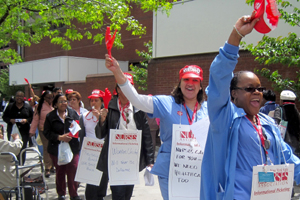Don't Take Medicaid Cuts Out on Us, Say NY Nurses

“Safe staffing saves lives!” chanted nurses in front of the huge Montefiore hospital complex in the Bronx, New York. “Bonuses for CEOs, cutbacks for nurses,” they yelled.
The noisy picket was part of a statewide protest at 15 facilities by the NYSNA nurses union, responding to the drastic New York state budget. Passed in March, the spending plan includes $5 billion in cuts to Medicaid, which hospitals are trying to then pass on to nurses in the form of benefit cuts.
Nurses on shift at Montefiore took 15 minutes break time to march and then went back to work, so new faces from among the hospital’s 3,000 RNs constantly joined the crowd, all wearing red nurse union hats. They blew whistles and cheered as passing cars and ambulances honked their horns.
The Montefiore nurses have been working for four months with an expired contract, but the main thing that eats at them day to day is their workload.
“We’re working under intolerable conditions here; the loads are intense. We’re very overworked and we worry about patient safety,” said Judy Sheridan-Gonzalez, president of the Montefiore unit.
“We have the worst nursing ratios in the area,” said Mary Fitzgerald, who has worked at the facility for 27 years. “We have one nurse for seven patients when we should have one nurse for five patients.”
Fitzgerald said nurses regularly work through their lunches and skip breaks because of chronic understaffing. “They’re not being paid for that, but they’re not going to abandon their patient,” Fitzgerald said.
Sheridan-Gonzalez works in the emergency room, one of the busiest in the country. “You can’t fit between stretchers, it’s so overcrowded,” she said.
Susan Walter, a nurse union staffer, said patients stack up in the hallways. Management is “so greedy that they won’t send a patient to another hospital because they don’t want to lose the money,” she said, even though the hospital doesn’t have enough rooms.

SUPPORT LABOR NOTES
BECOME A MONTHLY DONOR
Give $10 a month or more and get our "Fight the Boss, Build the Union" T-shirt.
“It’s an assembly line, get the patient in, get them out,” Fitzgerald said.
CHANDELIERS AND FOUNTAINS
Across the bargaining table, the nurses keep hearing that there’s not enough money to increase staffing and pay their benefits. But the nurses calculated that Montefiore could hire 56 new nurses for what it paid its CEO in 2008. The top three executives made $15 million that year, according to the “nonprofit” hospital’s IRS filings.
Nurses question other priorities at the hospital, which is making money, Walter said. Last year the hospital built an entranceway fountain. This year they’re building a marble lobby with a spiral staircase and a chandelier, she said, and they’re putting in ballrooms and high-tech conference rooms.
Meanwhile the union called OSHA because several nurses' lounges were “hazardous and filthy with exposed wires, vermin, and crumbling plaster,” Sheridan-Gonzalez said.
“But they’re telling us that they’re going to cut back on our benefits,” she said.
Alleging collusion to depress wages and benefits, the union filed an anti-trust complaint last month against the League of Voluntary Hospitals, an association of 100-plus New York City-area hospitals to which Montefiore belongs.
NYSNA staffer Nancy Kaleda said the hospital association trades non-public information, coordinates bargaining demands, and shares consultants and bargainers across facilities, all of which serve to advance management’s agenda of wage freezes and benefit cuts.
Montefiore nurses say they took a substantial pay cut previously to finance retiree health care. This year, management claimed to have a “fixed envelope” of money, and said nurses could get better staffing only by agreeing to cut their health benefits, especially retiree health benefits.
“We’re saying no, you need to go back and get a bigger envelope,” Walter said. “We’re not selling out retired people.”





